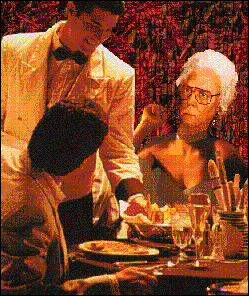Bon Appetit Cooper!

Photo above of "Ma" Cooper in 1923 at Bluenose Ferry Captain's dinner.
How many furniture sales are lost because the sales person and the consumer are not speaking the same language? All of us know that the first step in the sales process is to qualify the customer; to learn their wants, needs and desires. Talking to customers is one thing, but communicating with them is much different.
The sales process begins by successfully opening the lines of communication between the sales person and the customer. You may wait on this customer many times as she moves through the various stages of the buying process, but if you are speaking different languages you are simply pitching product. You have not learned how you might fulfill those wants, needs and desires. According to the Wirthlin Report, co-sponsored by the Home Furnishings Council and the AFMA, in order to learn what language your customer is speaking, you must first determine if she is a confident or a non-confident buyer. Each buyer type is distinct, and each progresses through a different buying process. The Wirthlin study shows us that each group has different attitudes, different motivations, emotions and behavioral patterns. If learning the customers' language is not the first step in your qualification process, you will talk to the customer, but you will not communicate. You will not close the sale.
The difference between talking and communicating reminds me of the first time that old Ma Cooper took to the sea. She booked passage aboard the Bluenose Ferry, a large Canadian-owned ship that plies the Atlantic between Bar Harbor, Maine and Dartmouth, Nova Scotia each summer. The first day at sea Ma went to her assigned table for breakfast and was joined by a polite Frenchman who, before sitting down, bowed, smiled and said, "Bon appetit."
Not to be outdone, old Ma stood up, curtseyed and said, "Cooper."
This little act was played out at every meal for two days. The Frenchman always arrived late for the meal, bowed, smiled and said, "Bon appetit." Each time, getting more confused by the day, old Ma Cooper would stand up, curtsy and say, "Cooper."
On the third day, Ma was in the bar having her second medicinal dose of Royal Crown with a twist, when she confided in the bartender. "Every darn meal this Frenchman tells me his name, Bon Appetit, and then I tell him my name. Land sakes! So we know each other! Why does he keep it up meal after meal after meal?"
"You don't understand, Ma, Bon appetit is not his name, said the bartender. He's wishing you a good appetite, he's hoping that you have a pleasant meal."
"Well, I'll be. It's a language problem. Tonight I'll show that little fella I know what he's talkin' about."
That evening, it was Ma Cooper who showed up late for dinner. Before sitting down, Ma curtseyed, smiled and said, "Bon Appetit." The Frenchman rose, bowed, smiled and said, "Cooper!"
Ma Cooper and the friendly little Frenchman were talking to each other, but they were not communicating. Don't make the same mistake with your customers. Take the advice of the Home Furnishings Council, the AFMA and The Wirthlin Group. Identify your customer and learn to speak their language.
Each time you greet a customer remember, "Bon appetit. Cooper."
For more information on how your store can benefit from membership in the Home Furnishings Council, write to Ma Cooper care of Furniture World at russpage@furninfo.com.